Related Research Articles
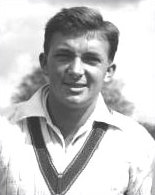
Richard Benaud was an Australian cricketer who played for New South Wales and Australia. Following his retirement from international cricket in 1964, Benaud became a highly regarded commentator on the game.
Peter Barker Howard May was an English cricketer who played for Surrey County Cricket Club, Cambridge University and England. Already a cricketing prodigy during his school days, May played his entire cricket career as an amateur, and was regarded by many players and fans as England's finest batsman in the post-war era.
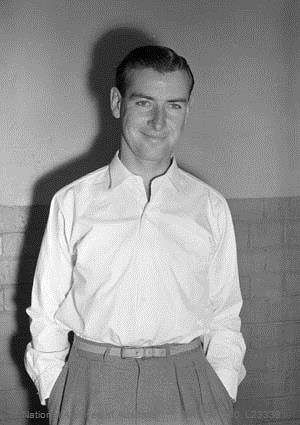
Ian Meckiff is a former cricketer who represented Australia in 18 Test matches between 1957 and 1963. A left-arm fast bowler, he is best known for two matters that were unrelated to his skill as a player: he was the batsman run out by Joe Solomon in 1960, causing the first Tied Test in cricket history; and in December 1963, his career was sensationally ended when he was called for throwing in the First Test against South Africa by Australian umpire Col Egar. During the late 1950s and early 1960s, there had been a media frenzy about the perceived prevalence of illegal bowling actions in world cricket. The controversy and speculation that dogged Meckiff in the years preceding his final match caused sections of the cricket community to believe that he had been made a scapegoat by the Australian cricket authorities to prove their intent to stamp out throwing.

Guy William Fitzroy Overton was a New Zealand international cricketer who played three Test matches in 1953–54. In domestic cricket he represented Otago from 1945–46 to 1955–56.
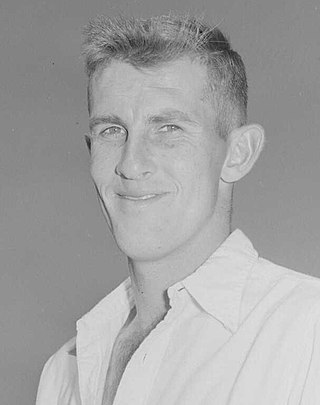
John Chaloner Alabaster was a New Zealand cricketer who played 21 Test matches for the country's national team between 1955 and 1972. A leg-spin bowler, he was the only New Zealander to play in each of the country's first four Test victories. In domestic cricket, he was often partnered at the crease for his provincial side Otago by his younger brother Gren, who bowled off-spin. A schoolteacher, he later served as Rector of Southland Boys' High School in Invercargill.

Leonard Arthur Butterfield was a New Zealand cricketer who played in one Test in 1946. He later served as New Zealand's chief harness racing stipendiary steward.

The Otago cricket team, nicknamed the Volts since the 1997–98 season, are a New Zealand first-class cricket team which first played representative cricket in 1864. The team represents the Otago, Southland and North Otago regions of New Zealand's South Island. Their main governing board is the Otago Cricket Association which is one of six major associations that make up New Zealand Cricket.
Dennis John Vear was a New Zealand cricketer who played three first-class matches for Otago in the early 1960s. He also played for Southland in the Hawke Cup competition.
This article describes the history of New Zealand cricket from the 1945–46 season until 1970.

The 1958–59 Ashes series consisted of five cricket Test matches, each scheduled for six days with eight ball overs. It formed part of the MCC tour of Australia in 1958–59, and the matches outside the Tests were played in the name of the Marylebone Cricket Club. The England team led by Peter May was labelled the strongest ever to leave England. It had the formidable bowling attack of Fred Trueman, Frank Tyson, Brian Statham, Peter Loader, Jim Laker and Tony Lock; the all-rounder Trevor Bailey; the outstanding wicket-keeper Godfrey Evans; and the batting of Colin Cowdrey, Tom Graveney, Raman Subba Row and Ted Dexter. They had won the last three Ashes series in 1953, 1954–55 and 1956, but lost the series 4–0 to Australia. It was one of the biggest upsets in Test cricket history and the biggest margin of defeat in an Ashes series since the 5–0 "whitewashing" inflicted by Warwick Armstrong's Australians in 1920–21.
The 1958-59 Australians defeated the touring England team 4-0 in the 1958–59 Ashes series. They were seen by the English press as having little chance of winning the series against the powerful England touring team. They had only one recognised great player, Neil Harvey and had lost the fast bowling combination of Ray Lindwall and Keith Miller and the other veterans of Don Bradman's Invincible 1948 team. There were, however, signs of recovery to those who would see them and E.W. Swanton believed that on their home ground Australia would be a shade better than England. The best indication of the forthcoming series was the M.C.C. and Australian tours of South Africa in 1956-57 and 1957-58. South Africa had a strong team in the 1950s, stunning the cricketing world by drawing 2-2 in Australia in 1953-54, losing 3-2 in the closely fought 1955 series in England and fighting back from a 2-0 deficit to draw 2-2 with Peter May's England in 1956-57. In 1957-58 Ian Craig led a team labelled as the weakest to leave Australia to a 3-0 victory over the Springboks with Richie Benaud, Alan Davidson, Wally Grout, Ken Mackay, Colin McDonald, Jim Burke and Lindsay Kline all in fine form. Norm O'Neill was not taken on tour, but struck innings of 175 in three hours and 233 in four hours in successive games against Victoria and was regarded as the "New Bradman".
The Australia national cricket team toured New Zealand from February to April 1928 and played six first-class matches including two against the New Zealand national cricket team. This was before New Zealand began playing Test cricket.

While the Australian Test team was touring South Africa in the 1949–50 season, another Australian team captained by Bill Brown played 14 matches in New Zealand between February and April 1950, five of which were first-class. These included one match against the New Zealand national cricket team, but this was not granted Test status.
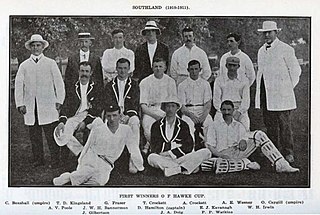
The Southland cricket team represents the Southland Region of New Zealand. They compete in the Hawke Cup.

John Drennan is a former first-class cricketer for South Australia. He toured New Zealand and South Africa with the Australian team but did not play Test cricket.

Daniel Jason McBeath was a New Zealand cricketer who played first-class cricket between the 1917–18 and 1926–27 seasons. He was born at Malvern in the Canterbury Region in 1897.
Charlie Frith was an English-born New Zealand cricketer who played first-class cricket for Canterbury and Otago between the 1877–78 and 1889–90 seasons.
The Australian cricket team toured New Zealand in January and February 1878, before their 1878 tour of England. It was the first overseas tour by a representative Australian team.
The Australian cricket team toured New Zealand in January and February 1881. The Australians played ten matches against provincial teams, nine of which fielded 22 players with the aim of providing more evenly-matched contests. Two further brief matches were played to fill the allotted time after a scheduled match finished early. As none of the matches were 11-a-side they are not considered to have been first-class.
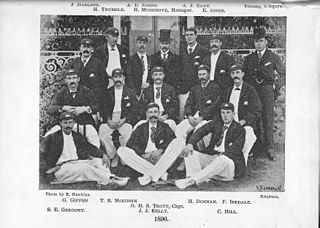
The Australian cricket team toured New Zealand in November 1896, playing five matches. They were returning from their 1896 tour of England.
References
- ↑ "Australia in New Zealand 1956/57". CricketArchive. Retrieved 21 August 2024.
- ↑ Wisden 1958, p. 847.
- ↑ Wisden 1958, p. 846.
- ↑ "Canterbury v Australians 1956/57". CricketArchive. Retrieved 21 August 2024.
- ↑ "Rapid Scoring Brings Win To Australia". The Canberra Times . Vol. 31, no. 9, 097. 19 February 1957. p. 10 – via National Library of Australia.
- ↑ "Southland v Australians 1956/57". CricketArchive. Retrieved 21 August 2024.
- ↑ "Australia Leads Southland On First Innings". The Canberra Times . Vol. 31, no. 9, 099. 21 February 1957. p. 10 – via National Library of Australia.
- ↑ "Otago v Australians 1956/57". CricketArchive. Retrieved 21 August 2024.
- ↑ "Ashburton County, South Canterbury and North Otago v Australians 1956–57". CricketArchive. Retrieved 21 August 2024.
- ↑ "New Zealand v Australia 1956–57 (I)". CricketArchive. Retrieved 21 August 2024.
- ↑ "Australians Fare Badly In N.Z." The Canberra Times . Vol. 31, no. 9, 107. 2 March 1957. p. 16 – via National Library of Australia.
- ↑ "New Zealand Refuses Run Chances". The Canberra Times . Vol. 31, no. 9, 109. 5 March 1957. p. 3 – via National Library of Australia.
- ↑ "Wairarapa v Australians 1956–57". CricketArchive. Retrieved 21 August 2024.
- ↑ "New Zealand v Australia 1956–57 (II)". CricketArchive. Retrieved 21 August 2024.
- ↑ "Poverty Bay v Australians 1956–57". CricketArchive. Retrieved 21 August 2024.
- ↑ ""Fantastic" Effort Gets N.Z. Wicket Ready For Play". The Canberra Times . Vol. 31, no. 9, 118. 15 March 1957. p. 4 – via National Library of Australia.
- ↑ "Auckland v Australians 1956–57". CricketArchive. Retrieved 21 August 2024.
- ↑ "Auckland Loses To Australia". The Canberra Times . Vol. 31, no. 9, 121. 19 March 1957. p. 10 – via National Library of Australia.
- ↑ "Waikato v Australians 1956–57". CricketArchive. Retrieved 21 August 2024.
- ↑ "Central Districts v Australians 1956–57".
- ↑ "New Zealand v Australia 1956–57".
- ↑ "Australians Batting".
- ↑ "Australians Bowling".